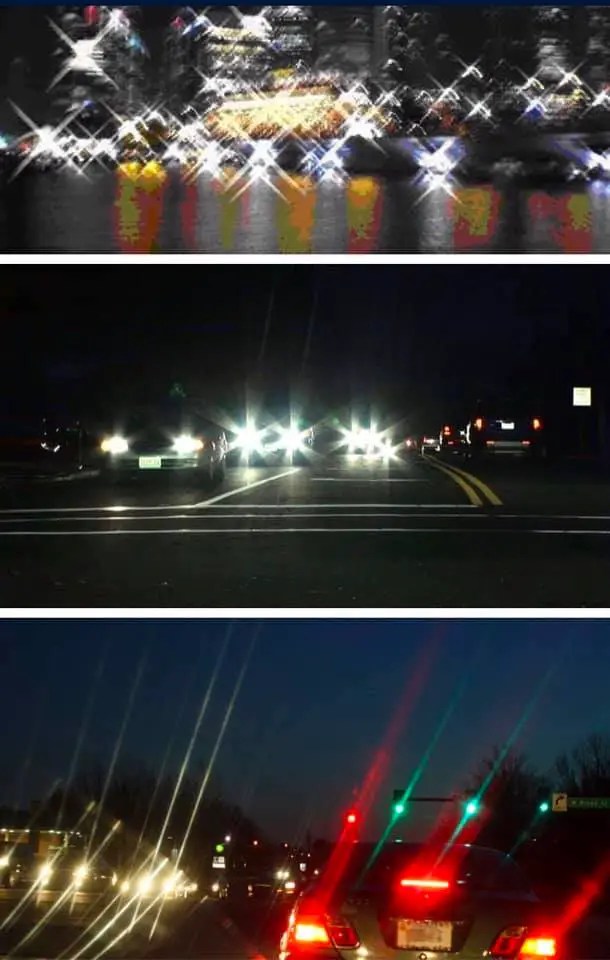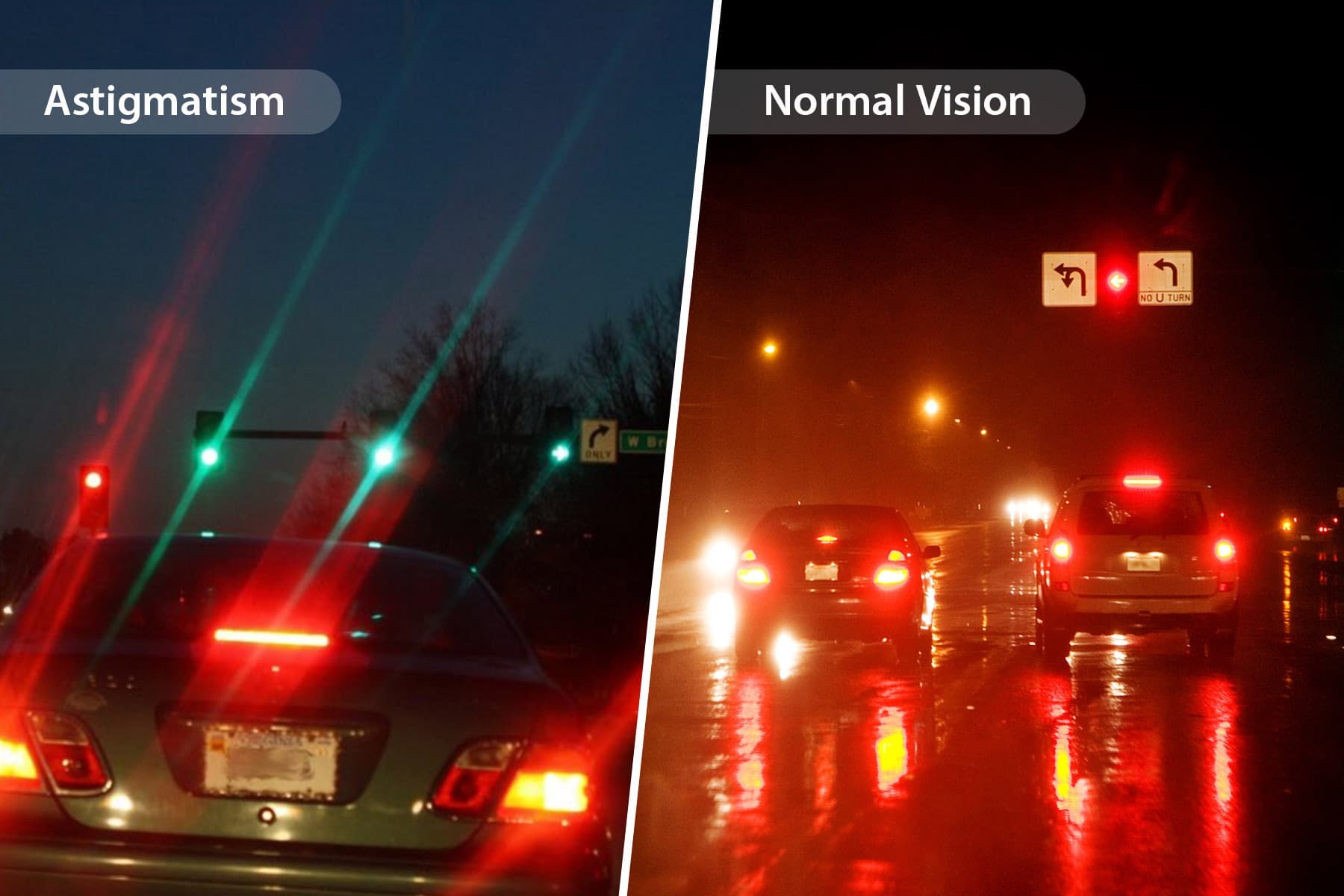
Astigmatism lights at night in rain, a common optical phenomenon, occurs when light passes through an irregularly shaped cornea or lens, causing distorted and elongated streaks of light, particularly around bright sources at night.
This phenomenon is relevant in various fields, including vision science, automotive safety, and optical engineering. It affects individuals with astigmatism, a condition that results in blurred vision and distorted images. Historically, the understanding of astigmatism lights at night in rain has evolved with advancements in optics and ophthalmology.
This article will delve into the causes, effects, and visual implications of astigmatism lights at night in rain, exploring its impact on driving safety, visual acuity, and corrective measures.
Astigmatism Lights at Night in Rain
Understanding the essential aspects of astigmatism lights at night in rain is crucial for various reasons, including visual acuity, driving safety, and optical engineering. These aspects encompass the causes, effects, and visual implications of this optical phenomenon.
- Definition
- Causes
- Effects
- Visual Implications
- Driving Safety
- Optical Engineering
- Corrective Measures
- Prevalence
- Diagnosis
- Historical Context
These aspects are interconnected and provide a comprehensive understanding of astigmatism lights at night in rain. For instance, understanding the causes helps in developing effective corrective measures, while assessing the visual implications aids in designing safer driving conditions. Furthermore, exploring the historical context sheds light on the evolution of our knowledge and technological advancements in this field.
Definition
A comprehensive definition of astigmatism lights at night in rain is essential for understanding this optical phenomenon. By defining it as the distorted and elongated streaks of light, particularly around bright sources at night, caused by the irregular shape of the cornea or lens, we establish a foundation for further exploration.
This definition highlights the cause-and-effect relationship between the irregular corneal or lens shape and the resulting distorted lights. Without a clear definition, it would be challenging to grasp the nature and behavior of this phenomenon, hindering our ability to develop effective corrective measures and understand its implications fully.
Real-life examples illustrate the practical significance of this definition. For instance, individuals with astigmatism often experience blurred vision and distorted images, particularly at night when bright lights are present. This is a direct consequence of the irregular corneal or lens shape, as defined. Understanding this connection enables us to develop corrective lenses or surgical procedures that can reshape the cornea and improve visual acuity.
In summary, a precise definition of astigmatism lights at night in rain is crucial for understanding its causes, effects, and visual implications. It provides a foundation for further research, diagnosis, and the development of corrective measures. By defining this phenomenon accurately, we can effectively address its challenges and enhance visual experiences.
Causes
Understanding the causes of astigmatism lights at night in rain is crucial as they directly determine the nature and behavior of this optical phenomenon. The irregular shape of the cornea or lens is the primary cause of astigmatism, leading to distorted and elongated streaks of light, particularly around bright sources at night. This irregular shape prevents light from focusing correctly on the retina, resulting in blurred vision and distorted images.
Real-life examples illustrate the practical significance of understanding these causes. Individuals with astigmatism often experience difficulty driving at night, especially in rainy conditions. The presence of bright headlights from oncoming vehicles can exacerbate the distortion and glare, making it challenging to see clearly. Similarly, individuals with astigmatism may struggle with night vision activities such as stargazing or reading road signs due to the distorted light patterns.
The practical applications of understanding the causes of astigmatism lights at night in rain are numerous. By identifying the underlying cause, eye care professionals can develop effective corrective measures tailored to the individual's specific needs. Corrective lenses or surgical procedures can reshape the cornea, reducing the distortion and improving visual acuity. Additionally, understanding the causes helps in designing safer driving conditions for individuals with astigmatism, such as reducing glare from headlights or providing better lighting in public areas.
Effects
The effects of astigmatism lights at night in rain encompass various dimensions, ranging from visual disturbances to implications for daily activities. Understanding these effects is critical for assessing the impact of this optical phenomenon on individuals and developing effective corrective measures.
- Visual Disturbances
Astigmatism lights at night in rain can cause blurred vision, distorted images, and elongated streaks of light, particularly around bright sources. This distortion occurs due to the irregular shape of the cornea or lens, preventing light from focusing correctly on the retina.
- Glare and Halos
Individuals with astigmatism often experience increased glare and halos around bright lights at night. These effects are caused by the scattering of light as it passes through the irregular cornea or lens.
- Reduced Contrast Sensitivity
Astigmatism can reduce contrast sensitivity, making it difficult to distinguish between objects with similar brightness levels. This effect can be particularly problematic in low-light conditions or when driving at night.
- Eyestrain and Headaches
Prolonged exposure to astigmatism lights at night in rain can lead to eyestrain, headaches, and fatigue. This is because the eyes work harder to focus and process the distorted images.
These effects collectively contribute to the challenges faced by individuals with astigmatism, particularly in night-time driving and other low-light conditions. Understanding these effects is crucial for developing effective corrective measures, such as eyeglasses, contact lenses, or surgical procedures, to improve visual acuity and reduce the impact of astigmatism lights at night in rain.
Visual Implications
Visual implications encompass a wide range of effects experienced by individuals with astigmatism, particularly when encountering lights at night in rainy conditions. These implications stem from the distorted and elongated streaks of light caused by the irregular shape of the cornea or lens.
- Blurred Vision
Astigmatism can result in blurred vision, especially at night when bright lights are present. This blurring occurs because the irregular corneal or lens shape prevents light from focusing correctly on the retina.
- Glare and Halos
Individuals with astigmatism often experience increased glare and halos around bright lights at night. These effects arise from the scattering of light as it passes through the irregular cornea or lens.
- Reduced Contrast Sensitivity
Astigmatism can reduce contrast sensitivity, making it difficult to distinguish between objects with similar brightness levels. This effect can be particularly problematic in low-light conditions or when driving at night.
- Eyestrain and Headaches
Prolonged exposure to astigmatism lights at night in rain can lead to eyestrain, headaches, and fatigue. This occurs because the eyes work harder to focus and process the distorted images.
These visual implications collectively contribute to the challenges faced by individuals with astigmatism, particularly in night-time driving and other low-light conditions. Understanding these implications is crucial for developing effective corrective measures, such as eyeglasses, contact lenses, or surgical procedures, to improve visual acuity and reduce the impact of astigmatism lights at night in rain.
Driving Safety
Driving safety is a critical aspect to consider when discussing astigmatism lights at night in rain. The distorted and elongated streaks of light caused by astigmatism can significantly impact an individual's ability to drive safely, particularly in low-light conditions.
- Reduced Visibility
Astigmatism can reduce visibility at night, making it difficult to see pedestrians, other vehicles, and road signs. This reduced visibility increases the risk of accidents.
- Increased Glare
Individuals with astigmatism often experience increased glare from headlights of oncoming vehicles. This glare can be blinding and make it difficult to see the road ahead.
- Distorted Perception of Distance
Astigmatism can distort the perception of distance, making it difficult to judge how far away objects are. This can lead to misjudgments and accidents.
- Eyestrain and Fatigue
Driving with astigmatism at night can cause eyestrain and fatigue. This can make it difficult to stay focused and alert while driving.
These factors collectively highlight the importance of addressing astigmatism lights at night in rain to improve driving safety. Individuals with astigmatism should take precautions such as wearing corrective lenses or glasses, keeping their headlights clean, and avoiding driving in low-light conditions whenever possible. By understanding the impact of astigmatism on driving safety, we can take steps to mitigate these risks and ensure a safer driving experience for all.
Optical Engineering
Optical engineering plays a crucial role in understanding and addressing astigmatism lights at night in rain. Astigmatism, a condition that causes distorted vision due to an irregular corneal shape, can lead to significant visual disturbances, particularly in low-light conditions. Optical engineering provides the foundation for developing corrective lenses and surgical techniques that can reshape the cornea and improve visual acuity.
One of the key challenges in optical engineering for astigmatism lights at night in rain is designing lenses that can effectively correct the distorted light patterns. This requires a deep understanding of the optical principles governing light refraction and diffraction. Engineers use advanced computer modeling and simulation techniques to design lenses that can minimize glare, halos, and other visual disturbances caused by astigmatism.
Real-life examples of optical engineering applications in astigmatism lights at night in rain include specialized eyeglasses and contact lenses. These lenses are designed to correct the irregular corneal shape, reducing distortion and improving visual clarity. Additionally, refractive surgery procedures, such as LASIK and PRK, use lasers to reshape the cornea, reducing or eliminating astigmatism and improving night vision.
Understanding the connection between optical engineering and astigmatism lights at night in rain has significant practical applications. By developing effective corrective measures, optical engineers can improve the quality of life for individuals with astigmatism, enhancing their visual function and safety, especially in low-light conditions. Furthermore, advancements in optical engineering contribute to the development of new technologies and treatments for vision correction, benefiting not only individuals with astigmatism but also the broader field of ophthalmology.
Corrective Measures
In the context of astigmatism lights at night in rain, corrective measures encompass various approaches to mitigate the visual disturbances caused by the irregular corneal shape. These measures aim to improve visual clarity, reduce glare and halos, and enhance overall visual function, particularly in low-light conditions.
- Eyeglasses and Contact Lenses
Eyeglasses or contact lenses with cylindrical lenses can correct the distorted light patterns caused by astigmatism. These lenses reshape the incoming light, compensating for the irregular corneal curvature and providing clearer vision.
- Refractive Surgery
Refractive surgery procedures, such as LASIK and PRK, use lasers to reshape the cornea, reducing or eliminating astigmatism. By altering the corneal curvature, these procedures aim to provide long-term correction and improve visual acuity.
- Orthokeratology
Orthokeratology involves the use of specialized contact lenses worn overnight. These lenses gently reshape the cornea over time, reducing astigmatism and improving vision. Orthokeratology can provide temporary correction, lasting typically for a day or two after the lenses are removed.
- Corneal Implants
In certain cases, corneal implants may be used to correct severe astigmatism. These implants are surgically placed into the cornea, altering its shape and improving visual clarity.
The choice of corrective measure depends on various factors, including the severity of astigmatism, the individual's lifestyle, and their overall eye health. By understanding the available corrective measures and their implications, individuals with astigmatism can make informed decisions to improve their vision and reduce the challenges posed by astigmatism lights at night in rain.
Prevalence
The prevalence of astigmatism plays a significant role in understanding the impact of astigmatism lights at night in rain. Astigmatism is a common condition affecting a large proportion of the population, with varying degrees of severity. Its prevalence influences the number of individuals experiencing distorted and elongated streaks of light, particularly in low-light conditions.
Individuals with astigmatism often report challenges with night vision, especially when driving in rainy conditions. The prevalence of astigmatism directly affects the frequency and severity of these visual disturbances, impacting the overall driving experience and safety. Understanding the prevalence of astigmatism helps in developing targeted interventions, such as public awareness campaigns and educational programs, to promote regular eye check-ups and early correction.
Real-life examples illustrate the practical significance of considering prevalence in astigmatism lights at night in rain. In countries with a high prevalence of astigmatism, there is a greater need for specialized driving regulations, improved road lighting, and the provision of assistive devices for individuals with low-light vision challenges. By recognizing the prevalence of astigmatism, policymakers and healthcare professionals can allocate resources effectively to address the needs of this population.
In summary, the prevalence of astigmatism is a critical component in understanding the challenges posed by astigmatism lights at night in rain. It influences the frequency and severity of visual disturbances, affects driving safety and overall quality of life, and guides the development of targeted interventions and resource allocation. Addressing the prevalence of astigmatism through comprehensive eye care programs and public health initiatives can significantly improve the visual outcomes and well-being of individuals affected by this condition.
Diagnosis
Diagnosis plays a crucial role in understanding and addressing astigmatism lights at night in rain. Astigmatism, a condition arising from an irregularly shaped cornea or lens, causes distorted and elongated streaks of light, especially noticeable in low-light conditions. Diagnosis involves a comprehensive eye examination to determine the presence and severity of astigmatism.
An accurate diagnosis is critical as it forms the basis for appropriate treatment and management of astigmatism. During an eye examination, an ophthalmologist or optometrist typically performs various tests, including visual acuity measurement, refraction assessment, and corneal topography. These tests help evaluate the shape of the cornea, the focusing ability of the eye, and the extent of astigmatism.
Real-life examples highlight the importance of proper diagnosis in astigmatism lights at night in rain. Individuals with undiagnosed or untreated astigmatism often experience difficulties with night vision, particularly when driving in rainy conditions. The distorted light patterns can lead to blurred vision, glare, and reduced contrast sensitivity, posing safety hazards. Timely diagnosis and correction of astigmatism can significantly improve visual clarity and reduce these challenges.
In summary, diagnosis is a vital component in the management of astigmatism lights at night in rain. It enables the identification and quantification of astigmatism, guiding appropriate treatment options and preventive measures. By understanding the connection between diagnosis and astigmatism lights at night in rain, we can emphasize the significance of regular eye examinations and encourage individuals to seek professional help if they experience visual disturbances, especially in low-light conditions.
Historical Context
Unveiling the connection between "Historical Context" and "astigmatism lights at night in rain" is crucial for a comprehensive understanding of this optical phenomenon. Historically, the study of astigmatism and its effects on vision has evolved alongside advancements in optics and ophthalmology. Understanding this historical context provides valuable insights into the causes, effects, and corrective measures associated with astigmatism lights at night in rain.
As early as the 18th century, scientists and physicians began to explore the nature of astigmatism and its impact on vision. Thomas Young, an English physicist, first described astigmatism in 1793, attributing it to irregularities in the curvature of the cornea or lens. Further research in the 19th century by scholars like George Biddell Airy and Hermann von Helmholtz led to the development of corrective lenses and surgical techniques to address astigmatism.
Real-life examples abound, showcasing the practical significance of understanding the historical context of astigmatism lights at night in rain. For instance, the invention of eyeglasses in the 13th century revolutionized vision correction, including for individuals with astigmatism. Similarly, the development of contact lenses in the 20th century provided a more convenient and comfortable option for astigmatism correction. These advancements have significantly improved the quality of life for countless individuals affected by astigmatism.
In summary, the "Historical Context" plays a critical role in elucidating the causes and effects of "astigmatism lights at night in rain." By delving into the historical evolution of optics and ophthalmology, we gain a deeper appreciation for the challenges posed by astigmatism and the ongoing efforts to address them. This understanding informs the development of effective corrective measures, improves patient outcomes, and contributes to the broader field of vision science.
In summary, our exploration of "astigmatism lights at night in rain" has illuminated the causes, effects, and visual implications of this optical phenomenon. By delving into its prevalence, diagnosis, and historical context, we have gained a deeper understanding of the challenges it poses and the corrective measures available.
Key insights from this article include:
- The irregular shape of the cornea or lens causes astigmatism, resulting in distorted and elongated streaks of light, particularly around bright sources at night.
- Astigmatism can lead to reduced visual acuity, increased glare, and eyestrain, significantly impacting driving safety and overall quality of life.
- Regular eye examinations and early diagnosis are crucial for proper management of astigmatism, with eyeglasses, contact lenses, and surgical procedures offering effective corrective solutions.
Dr Seus Cheating
Who Is Rubi Rose? Exploring The Ethnicity Of A Social Media Icon
Clown Attacks In Ohio: A Comprehensive Guide To Prevention, Safety, And Response

If You Have Astigmatism, This Is What Lights Look Like Truth or Fiction?

Glasses For Astigmatism Cheapest Retailers, Save 64 jlcatj.gob.mx

How to Drive at Night with Astigmatism or Poor Eyesight
ncG1vNJzZmibkaW5qrrEZ6psZqWoerix0q1ka2aRoq67u82arqxmk6S6cK3SraCgpZGptrS5jKWgoKCkqHqiwIynoKCgpGK2r3nRmqCnZpipuq0%3D